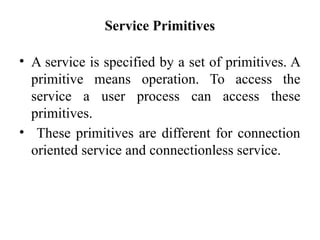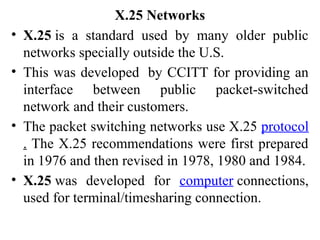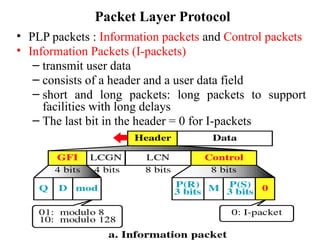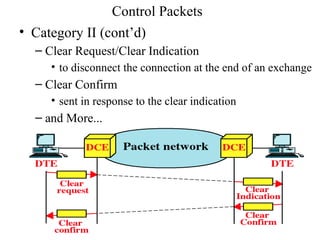Ad
Common Network Architecture: X.25 Networks, Ethernet (Standard and Fast): frame format and specifications, Wireless LAN’s – 802.11x, 802.3 Bluetooth etc.
- 1. Common Network Architecture Chapter No. 2
- 2. Connection oriented Vs Connection less network Connection-Oriented means that when devices communicate, they perform handshaking to set up an end-to-end connection. In connectionless design every packet is addressed and routed independently.
- 3. Connection oriented Protocols Characteristics: 1. Handshaking (Setting up connection) between communicating devices. Connections sometimes are called as sessions, virtual circuits or logical connections. 2. Acknowledgement procedure. This provides a high level of network reliability. 3. It provides means of error control. Whenever receiving station found that received data packet consist of errors it request sender to retransmit that packet. 4. It is a uni-cast (point-to-point) operation.
- 4. •Connection-oriented • Setup data transfer ahead of time (through handshaking) • Internet’s connection-oriented service is TCP (Transmission Control Protocol). It provides : • reliable, in-order byte delivery • flow control • congestion control. • Applications using TCP: Email (SMTP), web browsing (HTTP), and file transfer (FTP)
- 5. Connectionless (Stateless) Protocols Characteristics: • It sends data with a source and destination address without a handshake. • Do not use any acknowledgment procedure. • Usually do not support error control. • Connectionless protocols are more efficient than that of connection oriented protocols. • It allows multicast and broadcast operations.
- 6. •Connectionless Internet’s connectionless service is UDP (User Datagram Protocol) . It provides unreliable data transfer no flow control no congestion control Applications using UDP: streaming media, video conferencing, and IP telephony
- 7. A comparison of Connection-Oriented and Connectionless Network
- 8. Peer-to-Peer Network • A peer-to-peer network is a distributed network architecture composed of participants that make a portion of their resources, such as processing power, disk storage or network bandwidth directly to network participants without the need for central coordination instances. • Used largely for sharing of content files such as audio, video, data or anything in a digital format. • Can be very large
- 9. • End-systems (or peers), are capable of behaving as clients and servers of data, hence system is scalable and reliable • Peers participation is voluntary, membership is dynamic, hence topology keeps changing • Most popularly used for file sharing, hence peer- to-peer systems have become synonymous with peer-to-peer file sharing networks Peer-to-Peer Network
- 10. A Peer • Peers are both suppliers and consumers while in the traditional client-server model, the server supplies while the client only consumes.
- 12. Advantages • The more nodes that are part of the system, demand increases and total capacity of the system also increases. Where in client-server network architectures as more clients are added to the system, the system resources decreases. • There is no single point of failure, due to robustness of the system. • All clients provide to the system
- 13. Disadvantages • Security is a major concern, not all shared files are from beginning sources. Attackers may add malware to p2p files as an attempt to take control of other nodes in the network. • Heavy bandwidth usage • ISP speeding/slowing of P2P traffic. • Potential legal/moral concerns
- 14. CO Vs. CL • In connection oriented service authentication is needed while connectionless service does not need any authentication. • Connection oriented protocol makes a connection and checks whether message is received or not and sends again if an error occurs connectionless service protocol does not guarantees a delivery. • Connection oriented service is more reliable than connectionless service. • Connection oriented service interface is stream based and connectionless is message based.
- 15. Service Primitives • A service is specified by a set of primitives. A primitive means operation. To access the service a user process can access these primitives. • These primitives are different for connection oriented service and connectionless service.
- 16. • LISTEN : When a server is ready to accept an incoming connection it executes the LISTEN primitive. It blocks waiting for an incoming connection. • CONNECT : It connects the server by establishing a connection. Response is awaited. • RECIEVE: Then the RECIEVE call blocks the server. • SEND : Then the client executes SEND primitive to transmit its request followed by the execution of RECIEVE to get the reply. Send the message. • DISCONNECT : This primitive is used for terminating the connection. After this primitive one can’t send any message. When the client sends DISCONNECT packet then the server also sends the DISCONNECT packet to acknowledge the client. When the server package is received by client then the process is terminated. Connection Oriented Service Primitives
- 17. Primitives for Connectionless Oriented Service • UNIDATA - This primitive sends a packet of data • FACILITY, REPORT - Primitive for enquiring about the performance of the network, like delivery statistics.
- 18. X.25 Networks • X.25 is a standard used by many older public networks specially outside the U.S. • This was developed by CCITT for providing an interface between public packet-switched network and their customers. • The packet switching networks use X.25 protocol . The X.25 recommendations were first prepared in 1976 and then revised in 1978, 1980 and 1984. • X.25 was developed for computer connections, used for terminal/timesharing connection.
- 19. X.25 Networks • This protocol is based on the protocols used in early packet switching networks such as ARPANET, DATAPAC, and TRANSPAC etc. • A protocol X.21 which is a physical layer protocol is used to specify the physical electrical and procedural interface between the host and network. • The problem with this standard is that it needs digital signal rather than analog signals on telephone lines.
- 20. • So not many networks support this standard. Instead RS 232 standard is defined. • The data link layer standard has a number of variations. It is designed for error detection and corrections. • The network layer protocol performs the addressing, flow control, delivery confirmation etc. • It allows the user to establish virtual circuits and send packets on them. These packets are delivered to the destination reliably and in order. • X.25 is a connection oriented service. It supports switched virtual circuits as well as the permanent circuits.
- 21. • Packet Switching is a technique whereby the network routes individual packets of HDLC data between different destinations based on addressing within each packet. • A switched virtual circuit is established between a computer and network when the computer sends a packet to the network requesting to make a call to other computer. • Packets can then be sent over this connection from sender to receiver. • X.25 provides the flow control, to avoid a fast sender overriding a slow or busy receiver.
- 22. • A permanent virtual circuit is analogous to-a leased line. It is set up in advance with a mutual agreement between the users. • Since it is always present, no call set up is required for its use. • In order to allow the computers which do not use the X.25 to communicate with the X.25 network a packet assembler dis-assembler (PAD) is used. • PAD is required to be installed along with each computer which does not use X.25. • X.25 defines the interface for exchange of packets between a DTE and switch data sub-network node.
- 23. • X.25 Most widely used today • X.25 is an interface between DTE ( Data Terminal Equipment) and DCE (Data Communication Equipment) for terminal operation at the packet mode on public data network. – A packet switching protocol used in a wide area network – use virtual circuit and asynchronous TDM
- 24. • DTE stands for Data Terminal Equipment, and DCE stands for Data Communications Equipment. • DTE is typically either a dumb terminal or the serial port on a computer/workstation. • DCE is typically a modem, or other piece of data communications equipment, hence the names.
- 25. Three Layers of X.25 The X.25 interface is defined at three levels: The three levels are: (i) Physical layer (level 1) (ii) Data link layer (level 2) (iii) Packet layer (level 3).
- 26. • Layers
- 27. Encapsulation of PLP packet
- 28. • These three layers correspond to the three lower most layers of the ISO-OSI reference model. The physical layer takes care of the interface between a computer terminal and the link which attaches it to the packet switching node. • The X.25 defines the interface for exchange of packets between the user's machine (DTE- Data Terminal Equipment) and the packet switching node to which this DTE is attached which is called as DCE(Data Circuit Terminating Equipment).
- 29. • The three layers of X.25 interface are as shown in Fig.. • At the physical level X.21 physical interface is being used which is defined for circuit switched data network. At the data link level, X.25 specifies the link access procedure-B (LAP-B) protocol.
- 31. • At the network level (3rd level), X.25 defines a protocol for an access to packet data subnetwork. • This protocol defines the format, content and procedures for exchange of control and data transfer packets. The packet layer provides an external virtual circuit service. • Next Fig. shows the relationship between the levels of x.25. User data is passed down to X.25 level 3. • This data then appends the control information as a header to form a packet. This control information is then used in the operation of the protocol.
- 33. • The entire X.25 packet formed at the packet level is then passed down to the second layer i.e. the data link layer. • The control information is appended at the front and back of the packet forming a LAP-B frame. The control information in LAP-B frame is needed for the operation of the LAP-B protocol. • This frame is then passed to the physical layer for transmission.
- 34. Packet Layer Protocol • PLP packets : Information packets and Control packets • Information Packets (I-packets) – transmit user data – consists of a header and a user data field – short and long packets: long packets to support facilities with long delays – The last bit in the header = 0 for I-packets
- 35. Packet Layer Protocol • I-packet fields – General format identifier (GFI) field: 4 bits • Q bit : not defined in the standard. Users define two types of data. • D bit: for packet sequencing. • Mod: the length of the header. (01: the header short, 10: long) – Virtual circuit identification fields • Logical channel group number (LCGN) : 4 bits • Logical channel number (LCN) : 8 bits • total 12 bits to identify the virtual circuit for a transmission
- 36. Packet Layer Protocol • I-packet fields • P(S) and P(R) : packet sequence numbers for flow and error control • P(S) for packet send, P(R) for packet receive: sliding window ARQ
- 37. Packet Layer Protocol • Control Packets (C-packets) ~ flow and error control ~ connection, termination and management control – Category I (for flow and error control) • RR: Receive Ready - the station is ready to receive more packets • RNR: Receive Not Ready • REJ: Reject - an error in the packet (go-back-n ARQ)
- 38. Packet Layer Protocol • Control Packet (C-packet) – Category II • for connection, termination and management control • control packet types
- 39. Control Packets • Category II – Call Request/Incoming Call • request the establishment of a connection between two DTEs – Call Accepted/Call Connected • indicate the acceptance of the requested connection by the called system
- 40. Control Packets • Category II (cont’d) – Clear Request/Clear Indication • to disconnect the connection at the end of an exchange – Clear Confirm • sent in response to the clear indication – and More...
- 41. Packet Layer Protocol • Complete Packet Sequence – A message size may be too small or too large for a network and not compatible with a network. – X.25 mechanism to break up a long message among multiple packets but still keep those packets as a single contiguous transmission – A packets: at least one additional packets needed to carry the remainder of a message (M=1,D=0) - B packets: either stand alone or final packet (M=0, D=1) – final packet in the sequence need ACK( M=1,D=1)
- 42. Packet Layer Protocol • Complete Packet Sequence (cont’d)
- 43. Packet Layer Protocol • Virtual Channel ID Numbers – up to 4096 multiplexed channels to be identified between each DTE and DCE – not permanent, allocated dynamically – the calling and called hosts use different numbers
- 44. Virtual Circuit Service • With the X.25 packet layer, data are transmitted in packets over external virtual circuits, The virtual circuit service of X.25 provides for two types of virtual circuits. • The virtual circuit service of X.25 provides for two types of virtual circuits i.e. "virtual call" and "permanent virtual circuit".
- 45. Virtual Circuit Service • A virtual call is a dynamically established virtual circuit using a call set up and call clearing procedure. • A permanent virtual circuit is a fixed, network assigned virtual circuit. Data transfer takes place as with virtual calls, but no call set up or clearing is required.
- 46. Characteristics of X.25 • Multiple logical channels can be set on a single physical line • Terminals of different communication speeds can communicate • The procedure for transmission controls can be changed.





























































































